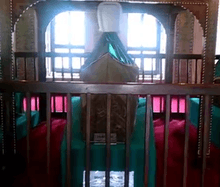Şehzade Mehmed
Şehzade Mehmed (Ottoman Turkish: شہزادہ محمد; 31 October 1522 – 7 November 1543) was an Ottoman prince (şehzade), the son of Sultan Suleiman the Magnificent and his consort Hurrem Sultan.[2]
| Şehzade Mehmed | |
|---|---|
 The tomb of Şehzade Mehmed inside Şehzade Mosque | |
| Governor of Manisa | |
| Tenure | 12 November 1542 – 7 November 1543 |
| Born | 31 October 1522[1] Old Palace, Istanbul, Ottoman Empire |
| Died | 7 November 1543 (aged 21) Manisa Palace, Manisa, Ottoman Empire |
| Burial | Şehzade Mosque, Istanbul |
| Issue | Hümaşah Sultan |
| Dynasty | Ottoman |
| Father | Suleiman the Magnificent |
| Mother | Hurrem Sultan |
| Religion | Sunni Islam |
Life
Şehzade Mehmed was born on 31 October 1522 in the Old Palace, during Suleiman's campaign to Rhodes. His birth was celebrated in the camp with sacrifices and distribution of alms.[1]
Mehmed was circumcissed together with his brothers, Şehzade Mustafa and Şehzade Selim on 27 June 1530.[3] In February 1534, Mustafa was appointed the governor of Manisa. Mehmed on the other hand remained in the capital, and in 1537, joined his father on his campaign to Corfu. In 1541, he and his younger brothers, Şehzade Selim, and Şehzade Bayezid, accompanied their father on his campaign to Buda.[4][5]
Suleiman favoured Hurrem's son, and appointed Mehmed, his second and much loved son, his heir contrary to the tradition.[6] Soon after their return from Corfu in October 1542, Suleiman under Hurrem's influence, appointed him the governor of Manisa. He also appointed Selim the governor of Karaman. Prior to the appointment, Prince Mustafa was sent to Amasya on 16 June 1541. Mehmed began his duties formally as governor soon after his arrival to Manisa on 12 November 1542.[4][6]
His mother, however, didn't accompanied him to his provincial post. A Manisa register indicates that she did, however, made trip to Mehmed in 1543. The same year, she also visited her younger son Prince Selim, who had been appointed the governor of Karaman.[7] His only child, Hümaşah Sultan was born in Manisa.[8]
Evliya Çelebi describes Mehmed as a "prince of more exquisite qualities than even Mustafa. He had a piercing intellect and a subtle judgment. Suleiman had intended that he would be his successor, but man proposes and God disposes".[9]
Death
Şehzade Mehmed fell ill in Manisa on Wednesday, 31 October 1543. He died shortly after, on Wednesday night, 7 November,[4] probably of small pox.[6] The following day, Lala Pasha, and Defterdar İbrahim Çelebi took his body to Istanbul. After his death his younger brother Selim replaced him as the governor of Manisa.[4]
After his Mehmed's death, Suleiman had the famed imperial architect Mimar Sinan build the Şehzade Mosque in Istanbul to commemorate Mehmed. Also, Suleiman composed an elegy for Mehmed and ended the poem with the line "Most distinguished of the princes, my Sultan Mehmed".[10][11]
In popular culture
In the 2011–2014 TV series Muhteşem Yüzyıl, Şehzade Mehmed is portrayed by Turkish actor Gürbey İleri.
See also
- Ottoman Empire
- Ottoman dynasty
- Ottoman family tree
- Line of succession to the Ottoman throne
- List of the mothers of the Ottoman Sultans
- List of consorts of the Ottoman Sultans
- Ottoman Emperors family tree (simplified)
References
- Yelçe, Nevin Zeynep (2009). The Making of Sultan Süleyman: A Study of Process/es of Image-Making and Reputation Management. p. 256.
- Peirce 1993, p. 59.
- Akbar, M.J (May 3, 2002). The Shade of Swords: Jihad and the Conflict between Islam and Christianity. Routledge. pp. 88. ISBN 978-1-134-45258-3.
- Sağır 2016, p. 922.
- "Şehzade Bayezid (ö. 969/1562): Kanûnî Sultan Süleyman'ın saltanat iddiasıyla isyan eden Hürrem Sultan'dan olma oğlu". İslam Ansiklopedisi. Retrieved 20 October 2019.
- Peirce 1993, p. 80.
- Peirce 1993, p. 61.
- Peirce 1993, p. 67, 68, 69.
- "Fisher. Suleyman and His Sons". Coursesa.matrix.msu.edu. Archived from the original on 2016-03-09. Retrieved 2017-02-26.
- "SULEYMAN THE MAGNIFICENT - POET". Web.archive.org. Archived from the original on 2006-03-09. Retrieved 2017-02-26.
- "Archived copy". Archived from the original on 2016-04-28. Retrieved 2016-04-16.CS1 maint: archived copy as title (link)
Sources
- Peirce, Leslie P., The Imperial Harem: Women and Sovereignty in the Ottoman Empire, Oxford University Press, 1993, ISBN 0-19-508677-5
- Sağır, Yusuf (2016). According to the Records and Vakfiyye’s the Foundation of Şehzade Mehmet.
